Automated Cell Culture Systems Market Size
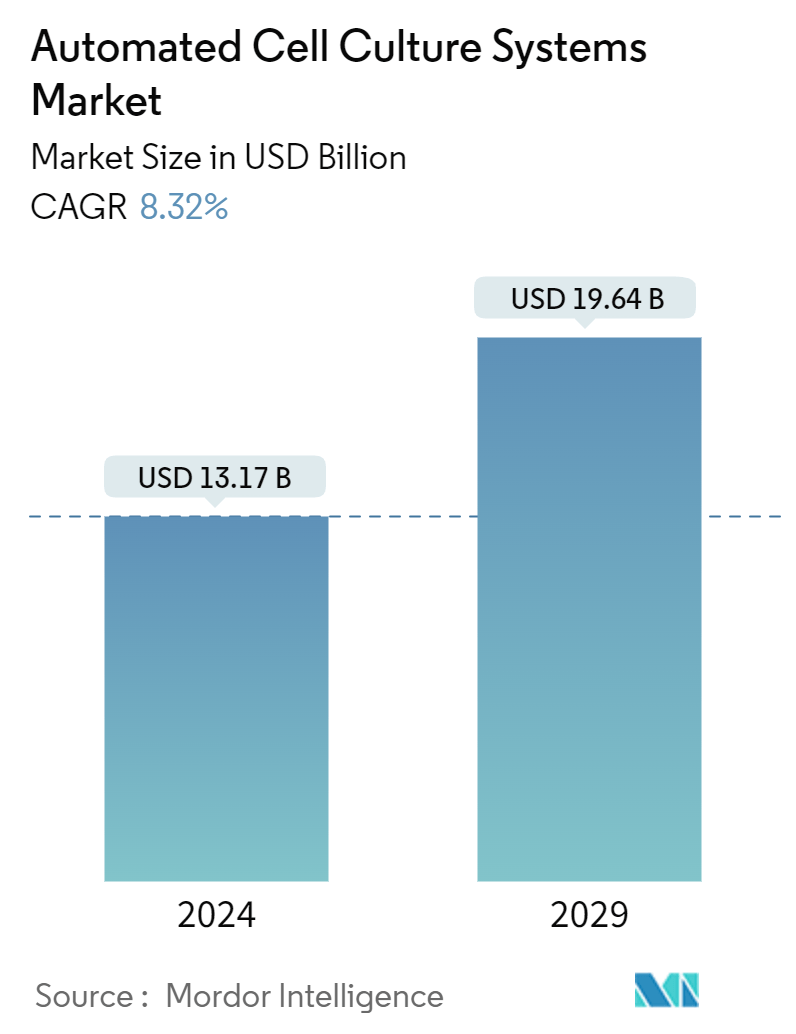
| Study Period | 2019 - 2024 |
| Market Size (2024) | USD 13.17 Billion |
| Market Size (2029) | USD 19.64 Billion |
| CAGR (2024 - 2029) | 8.32 % |
| Fastest Growing Market | Asia Pacific |
| Largest Market | North America |
Major Players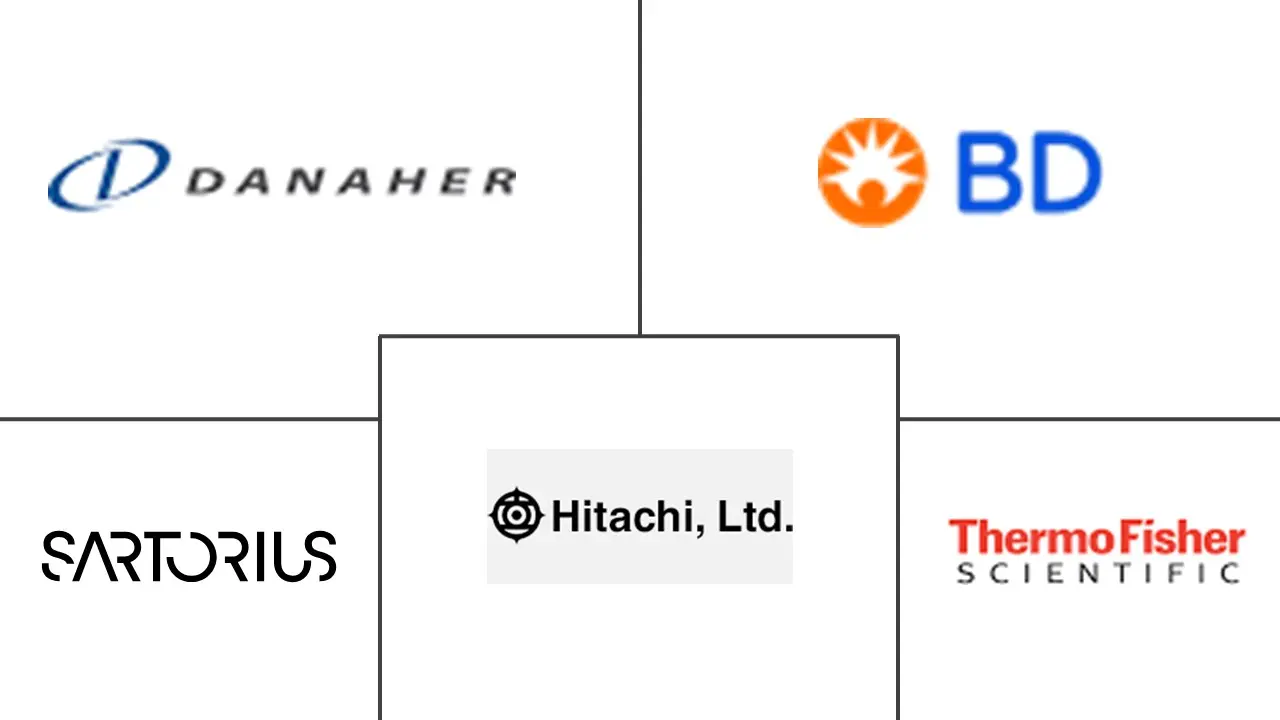
*Disclaimer: Major Players sorted in no particular order |
Automated Cell Culture Systems Market Analysis
The Automated Cell Culture Systems Market size is estimated at USD 13.17 billion in 2024, and is expected to reach USD 19.64 billion by 2029, growing at a CAGR of 8.32% during the forecast period (2024-2029).
The automated cell culture systems market is a dynamic and rapidly evolving sector within the life sciences and biotechnology industries. This market is influenced by the rise in the demand for biopharmaceuticals, advancements in cell-based research, and the need for precise, reproducible, and high-throughput cell culture processes. These systems offer enhanced productivity, reduced contamination risks, and improved data management, making them indispensable in applications ranging from drug discovery and vaccine production to regenerative medicine and personalized therapies. With ongoing technological innovations and a growing emphasis on automation in research and production, the automated cell culture systems market is poised for continued growth and innovation.
Chronic conditions are on the rise, including cancer, diabetes, and autoimmune diseases. Automated cell culture systems play a crucial role in drug discovery and development to address these health challenges. According to the National Center for Chronic Disease Prevention and Health Promotion (NCCDPHP) data published in December 2022, approximately six in ten Americans have at least one chronic disease. This signifies a high prevalence of chronic diseases, which significantly impacts research and developments in biopharmaceuticals.
Apart from this, the report released by the World Health Organization (WHO) in September 2023 points to the fact that around 41 million people die each year due to a chronic illness, which includes cardiovascular disorders followed by cancer and other chronic illnesses. This number projects a high number of treatment cases around the world, which would eventually impact the market’s growth. Biopharmaceuticals are required due to the rising burden of chronic diseases in the world, which is driving this market's expansion.
Apart from this, ongoing advancements in cell-based research, including regenerative medicine, tissue engineering, and personalized medicine, require precise and controlled cell culture conditions, which automated systems can provide. Factors such as collaboration for introducing new technologies in regenerative medicines and launching new systems further propel the market's growth.
For instance, Sony Group Corporation launched a new Cell Isolation System, CGX10, in December 2022. This device facilitates rapid cell sorting and can be used in studies to create cell-based products for industries like cell therapy and regenerative medicine. Also, for instance, in March 2023, Canon Inc. acquired assets of Kyoto Seisakusho Co. Ltd, which included the technology for mass production of cells for use in regenerative medicines and other clinical applications. These instances point out the growth of the market due to the advancements in this field of interest.
Therefore, the market is expected to grow during the forecast period due to factors such as the increased demand for biopharmaceuticals, rising incidence of chronic diseases, and advancements in cell-based research. However, factors such as high investment costs for the automated cell culture systems and regulatory compliance challenges act as restraining parameters for the market's growth.
Automated Cell Culture Systems Market Trends
The Drug Development Segment is Expected to Hold a Significant Market Share Over the Forecast Period
• The drug development segment is expected to increase rapidly because of the increased funding by government bodies in the drug development field during the forecast period. Automated cell culture systems play a crucial role in drug development by providing a controlled and efficient environment for the growth and manipulation of cells. The Department of Health and Human Services (HHS) National Institutes of Health (NIH) is the largest public supporter of biomedical research and development (R&D).
• According to the United States Government Accountability Office, NIH funded multiple R&D activities, with approximately USD 51 billion, contributing to drug development in 2022. The rise in funding can contribute to more research and development activities related to drug development, expanding the market for automated cell culture systems in the coming years.
• Apart from this, the launch of automated cell culture systems with respect to drug development is thriving in the market. For instance, CELLINK launched BIO CELLX to automate 3D cell cultures in March 2022. This product was launched to eliminate the difficulties faced by automating 3D cell-based assays in targeted drug discovery. This would further drive the growth of this particular segment of the market.
• Automated systems enable the rapid screening of thousands of compounds or drug candidates to identify potential leads that interact with a specific target or biological pathway. The above-mentioned factor would help with the significant growth of this segment in the coming years.
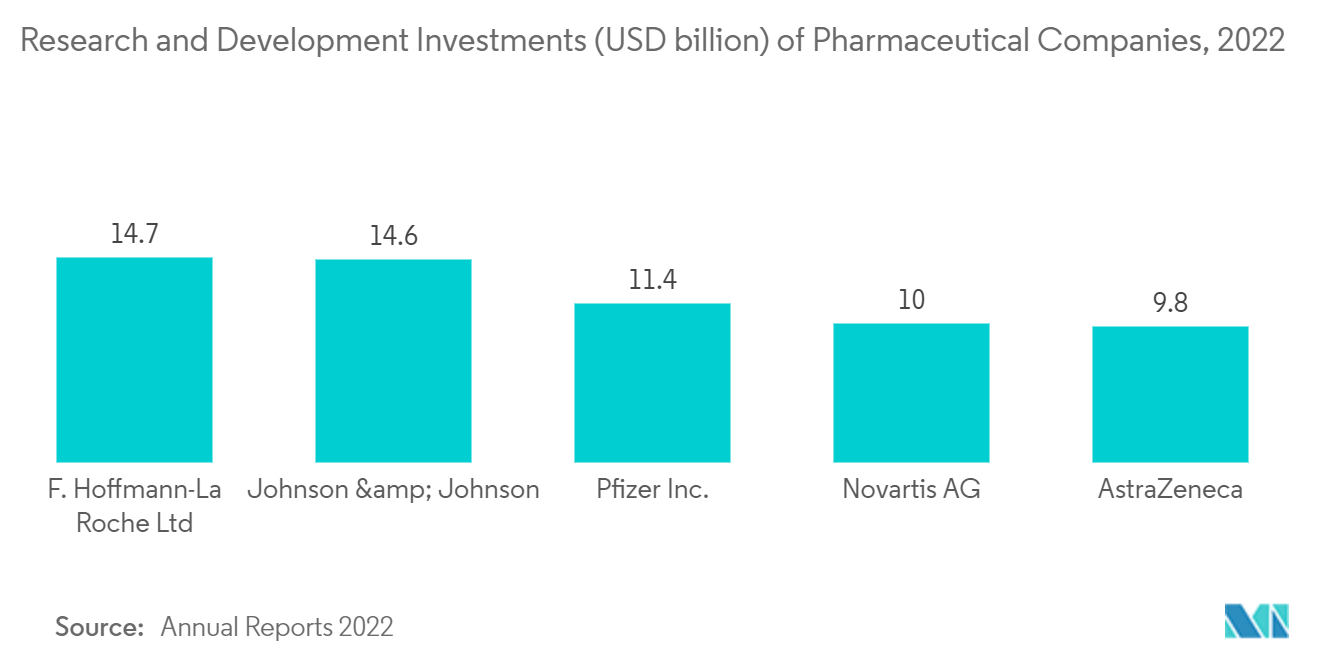
North America is Expected to be a Dominant Region Over the Forecast Period
• North America is expected to dominate the automated cell culture systems market during the forecasted period. This can be explained by factors such as the high demand for automated cell culture systems and advancements in cell cultures.
• North America has a significant biopharmaceutical industry, with a high demand for automated cell culture systems to support drug discovery, development, and production processes. Ongoing investments in research and development by pharmaceutical, biotechnology, and academic institutions in North America have driven the adoption of automated cell culture systems for innovative research.
• For instance, in May 2022, the University of Colorado Anschutz Medical Campus announced an investment of around USD 200 million over the following five years to establish a research and treatment center that will aim to develop new therapies, whether regenerative, cellular, or genetic for the treatment of a variety of chronic illnesses. Also, in July 2023, the California Institute for Regenerative Medicine (CIRM) invested approximately USD 50 million to fund clinical-stage research projects. This research will be focused on advancing stem cell and gene therapy treatments. The applicability of automated cell culture systems in cellular therapies, regenerative medicines, and other research areas increases its demand in this region. These parameters would be responsible for fueling the growth of the market in this region.
• The region is a hub for technological innovation, with companies continuously developing advanced automation technologies for cell culture systems, enhancing efficiency and precision. The advances in cell culture using 3D dynamic cell culture systems have been addressed with improvised automated cell culture systems. For instance, Corning launched Organoid Counting Software for the Corning Cell Counter in order to meet the requirements of the researchers working with predictive and complex 3D cell cultures, as mentioned in the articles published on the website in May 2022. The advances in cell cultures may be a major factor in this region's market.
• Therefore, owing to the above-mentioned factors, such as the increased demand for automated cell culture systems and strategic initiatives by market players, growth of the market is expected in the North American region.
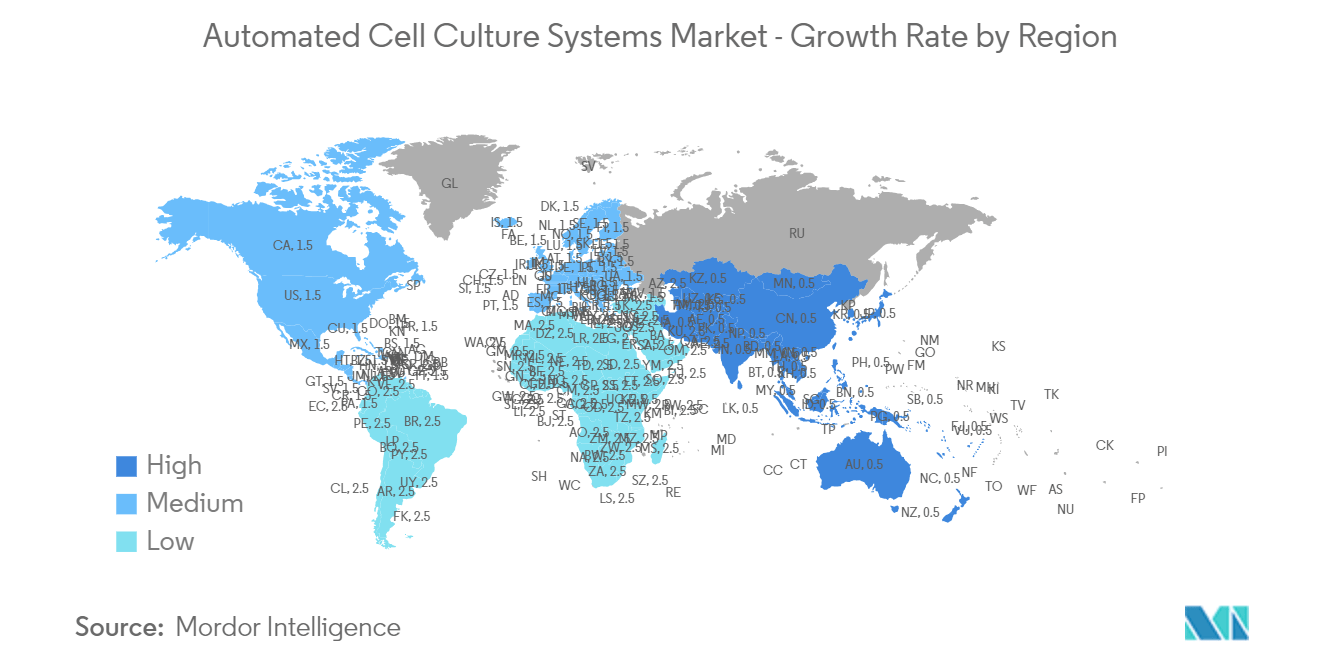
Automated Cell Culture Systems Industry Overview
The automated cell culture systems market is competitive. Market players invest significantly in R&D to develop advanced automated cell culture systems that offer improved functionality, ease of use, scalability, and compatibility with a wide range of cell types. Continuous innovation is crucial to stay competitive and meet the changing requirements of users. Some market players are Danaher (Beckman Coulter, Inc., Cytiva), Thermo Fisher Scientific Inc., Hitachi Ltd, Becton, Dickinson and Company (BD), and Sartorius AG.
Automated Cell Culture Systems Market Leaders
-
Danaher (Beckman Coulter, Inc., Cytiva)
-
Thermo Fisher Scientific Inc.
-
Hitachi, Ltd.
-
Becton, Dickinson and Company (BD)
-
Sartorius AG
*Disclaimer: Major Players sorted in no particular order
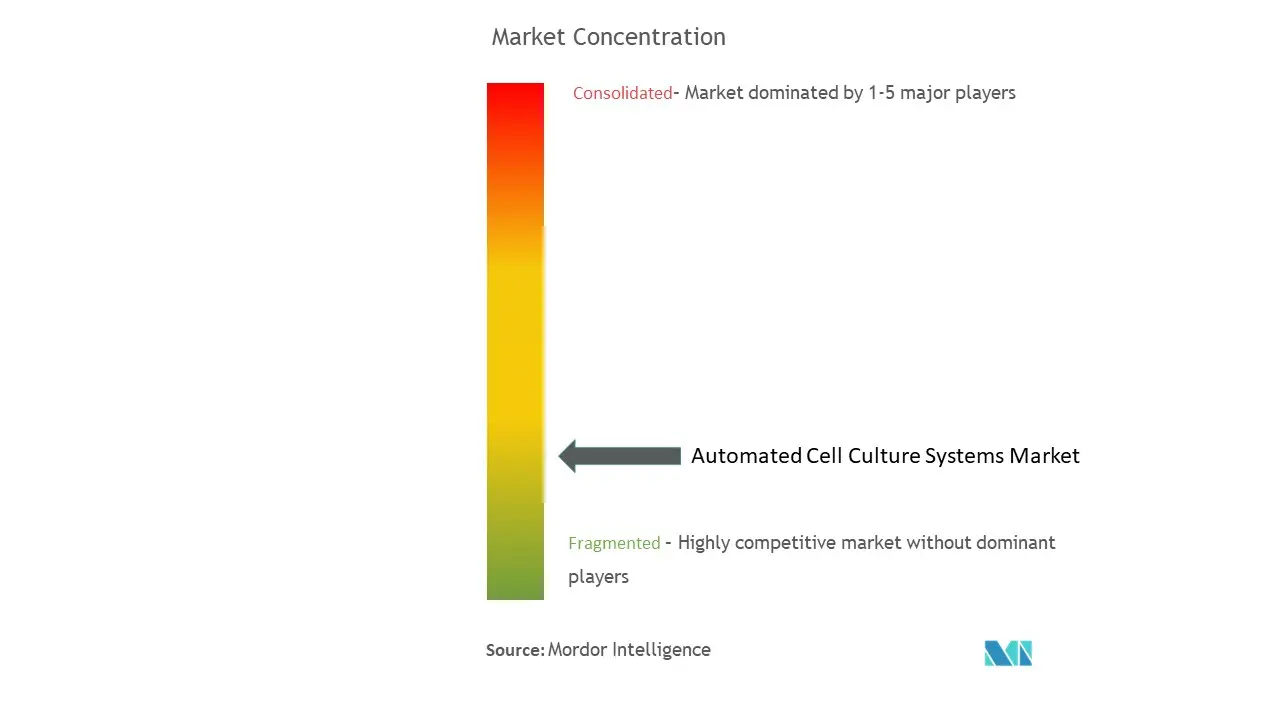
Automated Cell Culture Systems Market News
• In February 2023, Thermo Fisher Scientific Inc. formed a strategic collaboration with Celltrio, a leading manufacturer of robotics-based products in the life sciences sector. The focus of this collaboration was to introduce a cutting-edge, fully automated cell culture system tailored for biotherapeutics customers. This initiative aimed to meet the growing demand for high-throughput automated cell line culturing and maintenance.
• In May 2022, Cytiva inaugurated a state-of-the-art facility recognized as the Center of Excellence for cell and gene therapies. The products manufactured at this facility are destined for use in regulatory-approved therapies and clinical trials, showcasing Cytiva's commitment to advancing innovations in the field.
Automated Cell Culture Systems Market Report - Table of Contents
1. INTRODUCTION
- 1.1 Study Assumptions and Market Definition
- 1.2 Scope of the Study
2. RESEARCH METHODOLOGY
3. EXECUTIVE SUMMARY
4. MARKET DYNAMICS
- 4.1 Market Overview
-
4.2 Market Drivers
- 4.2.1 Increased Demand for Biopharmaceuticals and Rising Incidence of Chronic Diseases
- 4.2.2 Rise in the Research Funding in Life Sciences Research and Advancements in Cell-Based Research
-
4.3 Market Restraints
- 4.3.1 High Investment Costs for the Automated Cell Culture Systems
- 4.3.2 Regulatory Compliance Challenges
-
4.4 Porter's Five Forces Analysis
- 4.4.1 Threat of New Entrants
- 4.4.2 Bargaining Power of Buyers/Consumers
- 4.4.3 Bargaining Power of Suppliers
- 4.4.4 Threat of Substitute Products
- 4.4.5 Intensity of Competitive Rivalry
5. MARKET SEGMENTATION (Market Size by Value - USD)
-
5.1 By Product
- 5.1.1 Cell Culture Process Automation Instrument
- 5.1.2 Automated Bioreactor
- 5.1.3 Automated Cell Culture Media Exchange System
- 5.1.4 Automated Culture Media Analyzer
- 5.1.5 Automated Cell Counter
- 5.1.6 Other Products
-
5.2 By Cell Culture Type
- 5.2.1 Finite Cell Line Cultures
- 5.2.2 Infinite Cell Line Cultures
-
5.3 By Application
- 5.3.1 Cancer Research
- 5.3.2 Drug Development
- 5.3.3 Stem Cell Research
- 5.3.4 Regenerative Medicine
- 5.3.5 Cell Therapy
-
5.4 By End-User
- 5.4.1 Pharmaceutical Companies
- 5.4.2 Biotechnology Companies
- 5.4.3 CDMOs/CMOs
- 5.4.4 Research Organizations and Academic Institutes
- 5.4.5 Hospitals (Providing Cell Therapy/Regenerative Medicine)
-
5.5 Geography
- 5.5.1 North America
- 5.5.1.1 United States
- 5.5.1.2 Canada
- 5.5.1.3 Mexico
- 5.5.2 Europe
- 5.5.2.1 Germany
- 5.5.2.2 United Kingdom
- 5.5.2.3 France
- 5.5.2.4 Italy
- 5.5.2.5 Spain
- 5.5.2.6 Rest of Europe
- 5.5.3 Asia-Pacific
- 5.5.3.1 China
- 5.5.3.2 Japan
- 5.5.3.3 India
- 5.5.3.4 Australia
- 5.5.3.5 South Korea
- 5.5.3.6 Rest of Asia-Pacific
- 5.5.4 Middle East and Africa
- 5.5.4.1 GCC
- 5.5.4.2 South Africa
- 5.5.4.3 Rest of Middle East and Africa
- 5.5.5 South America
- 5.5.5.1 Brazil
- 5.5.5.2 Argentina
- 5.5.5.3 Rest of South America
6. COMPETITIVE LANDSCAPE
-
6.1 Company Profiles
- 6.1.1 Danaher (Beckman Coulter, Inc., Cytiva)
- 6.1.2 Thermo Fisher Scientific Inc
- 6.1.3 Hitachi, Ltd
- 6.1.4 Becton, Dickinson and Company (BD)
- 6.1.5 Sartorius AG
- 6.1.6 PerkinElmer Inc. (Nexcelom Bioscience LLC.)
- 6.1.7 Merck KGaA
- 6.1.8 F. Hoffmann-La Roche Ltd
- 6.1.9 Agilent Technologies, Inc.
- 6.1.10 Hamilton Company
- 6.1.11 Corning Incorporated
- 6.1.12 Shimadzu Corporation
- *List Not Exhaustive
7. MARKET OPPORTUNITIES AND FUTURE TRENDS
** Subject To AvailablityAutomated Cell Culture Systems Industry Segmentation
Automated cell culture systems are specialized laboratory equipment and setups designed to automate the process of growing and maintaining cell cultures.
The automated cell culture systems market is segmented into products, cell culture types, applications, end users, and geography. The market is segmented by product into cell culture process automation instruments, automated bioreactors, automated cell culture media exchange systems, automated culture media analyzers, automated cell counters, and others. By cell culture types, the market is segmented into finite cell line cultures and infinite cell line cultures. The market is segmented by application into cancer research, drug development, stem cell research, regenerative medicine, and cell therapy. By end user, the market is segmented into pharmaceutical companies, biotechnology companies, CDMOs/CMOs, research organizations, academic institutes, and hospitals providing cell therapy/regenerative medicine. The market is segmented by geography into North America, Europe, Asia-Pacific, the Middle East and Africa, and South America. The report offers the value (USD) for the above segments.
| By Product | Cell Culture Process Automation Instrument | |
| Automated Bioreactor | ||
| Automated Cell Culture Media Exchange System | ||
| Automated Culture Media Analyzer | ||
| Automated Cell Counter | ||
| Other Products | ||
| By Cell Culture Type | Finite Cell Line Cultures | |
| Infinite Cell Line Cultures | ||
| By Application | Cancer Research | |
| Drug Development | ||
| Stem Cell Research | ||
| Regenerative Medicine | ||
| Cell Therapy | ||
| By End-User | Pharmaceutical Companies | |
| Biotechnology Companies | ||
| CDMOs/CMOs | ||
| Research Organizations and Academic Institutes | ||
| Hospitals (Providing Cell Therapy/Regenerative Medicine) | ||
| Geography | North America | United States |
| Canada | ||
| Mexico | ||
| Geography | Europe | Germany |
| United Kingdom | ||
| France | ||
| Italy | ||
| Spain | ||
| Rest of Europe | ||
| Geography | Asia-Pacific | China |
| Japan | ||
| India | ||
| Australia | ||
| South Korea | ||
| Rest of Asia-Pacific | ||
| Geography | Middle East and Africa | GCC |
| South Africa | ||
| Rest of Middle East and Africa | ||
| Geography | South America | Brazil |
| Argentina | ||
| Rest of South America |
Automated Cell Culture Systems Market Research FAQs
How big is the Automated Cell Culture Systems Market?
The Automated Cell Culture Systems Market size is expected to reach USD 13.17 billion in 2024 and grow at a CAGR of 8.32% to reach USD 19.64 billion by 2029.
What is the current Automated Cell Culture Systems Market size?
In 2024, the Automated Cell Culture Systems Market size is expected to reach USD 13.17 billion.
Who are the key players in Automated Cell Culture Systems Market?
Danaher (Beckman Coulter, Inc., Cytiva), Thermo Fisher Scientific Inc., Hitachi, Ltd., Becton, Dickinson and Company (BD) and Sartorius AG are the major companies operating in the Automated Cell Culture Systems Market.
Which is the fastest growing region in Automated Cell Culture Systems Market?
Asia Pacific is estimated to grow at the highest CAGR over the forecast period (2024-2024).
Which region has the biggest share in Automated Cell Culture Systems Market?
In 2024, the North America accounts for the largest market share in Automated Cell Culture Systems Market.
What years does this Automated Cell Culture Systems Market cover, and what was the market size in 2023?
In 2023, the Automated Cell Culture Systems Market size was estimated at USD 12.07 billion. The report covers the Automated Cell Culture Systems Market historical market size for years: 2019, 2020, 2021, 2022 and 2023. The report also forecasts the Automated Cell Culture Systems Market size for years: 2024.
Automated Cell Culture Systems Industry Report
Statistics for the 2024 Automated Cell Culture Systems market share, size and revenue growth rate, created by Mordor Intelligence™ Industry Reports. Automated Cell Culture Systems analysis includes a market forecast outlook for 2024 to 2029 and historical overview. Get a sample of this industry analysis as a free report PDF download.



